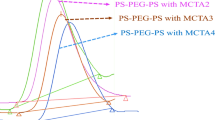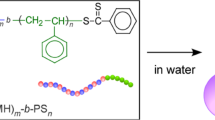Abstract
In polymer structure design, branching can occur randomly or by reactions designed to target specific architectures. This microstructural property affects many physical properties such as polydispersity, molecular weight and polymer chain size. A new reversible addition-fragmentation chain transfer/macromolecular design through interchange of xanthates (RAFT/MADIX) agents with polyvinyl alcohol was performed. In the process, polyvinyl alcohol (PVA), potassium hydroxide, carbon disulfide and derivatives of benzoylchloride were employed, and thus, three new graft chain transfer agents (g-CTA) were synthesized. PVA-g-PS graft copolymers were obtained using MADIX agents by changing various factors including initiator, amount of monomer and reaction time. While the linear increase in molecular weight with monomer consumption was observed, the polymerization reaction was kinetically detected to be the first order. Significant progress has been made in controlling the molecular weight distribution of the polymer by RAFT polymerization. The synthesized graft copolymers were characterized using FTIR, 1H NMR, 13C NMR, GPC and DSC techniques. Also, the three new graft chain transfer agents were characterized by elemental analysis and the existence of xanthate -S-(C = S) O-PVA was confirmed. The synthesis of the copolymer with the MADIX agent, which has an almost infinite number of design possibilities, was successfully achieved. As a result, well-defined statistical PVA-g-PS copolymers having a narrow molecular weight distribution (PDI 1.23–1.47) were obtained.














Similar content being viewed by others
References
Mustaqeem M, Saleh TA, ur Rehman A, Farooq Warsi M, Mehmood A, Sharif A, Akther S (2020) Synthesis of Zn0.8Co0.1Ni0.1Fe2O4 polyvinyl alcohol nanocomposites via ultrasound-assisted emulsion liquid phase. Arab J Chem 13:3246–3254
Sayed MM, Mousa HM, El-Aassar MR, El-Deeb NM, Ghazaly NM, Dewidar MM, Abdal-hay A (2019) Enhancing mechanical and biodegradation properties of polyvinyl alcohol/silk fibroin nanofibers composite patches for Cardiac tissue engineering. Mater Lett 255:126510
Kobayashi M, Toguchida J, Oka M (2003) Preliminary study of polyvinyl alcohol-hydrogel (PVA-H) artificial meniscus. Biomaterials 24:639–647
Zhang J, Liu T, Liu Z, Wang Q (2019) Facile fabrication of tough photocrosslinked polyvinyl alcohol hydrogels with cellulose nanofibrils reinforcement. Polymer 173:103–109
Rac V, Lević S, Balanč B, Olalde Graells B, Bijelić G (2019) PVA Cryogel as model hydrogel for iontophoretic transdermal drug delivery investigations:comparison with PAA/PVA and PAA/PVP interpenetrating networks. Colloid Surf B 180:441–448
Pundir CS, Sandeep Singh B, Narang J (2010) Construction of an amperometric triglyceride biosensor using PVA membrane bound enzymes. Clin Biochem 43:467–472
Sanaeifar N, Rabiee M, Abdolrahim M, Tahriri M, Vashaee D, Tayebi L (2017) A novel electrochemical biosensor based on Fe3O4 nanoparticles-polyvinyl alcohol composite for sensitive detection of glucose. Anal Biochem 519:19–26
Ma’Radzi AH, Sugihara S, Toida T, Maeda Y, (2014) Synthesis of polyvinyl alcohol stereoblock copolymer via the combination of living cationic polymerization and RAFT/MADIX polymerization using xanthate with vinyl ether moiety. Polymer 55:5332–5345
Segura T, Menes-Arzate M, León F, Ortega A, Burillo G, Peralta RD (2016) Synthesis of narrow molecular weight distribution polyvinyl acetate by gamma-rays initiated RAFT/MADIX miniemulsion polymerization. Polymer 102:183–191
Göktaş M (2019) Synthesis and characterization of various block copolymers using PMMA-Br macroinitiator. Chem Zvesti 73:2329–2339
Koyilapu R, Singha S, Kutcherlapati SNR, Jana T (2020) Grafting of vinylimidazolium-type poly(ionic liquid) on silica nanoparticle through RAFT polymerization for constructing nanocomposite based PEM. Polymer 195:122458
Mishra S, Rawal A, Nebhani L (2020) Imprinting the location of an in-built RAFT agent and selective grafting of polymer chains inside or outside the pores of mesoporous silica nanoparticles. Micropor Mesopor Mater 294:109898
Chmielarz P, Park S, Sobkowiak A, Matyjaszewski K (2016) Synthesis of β-cyclodextrin-based star polymers via a simplified electrochemically mediated ATRP. Polymer 88:36–42
Glaied O, Dubé M, Chabot B, Daneault C (2009) Synthesis of cationic polymer-grafted cellulose by aqueous ATRP. J Colloid Interface Sci 333:145–151
Guo H, Li X, Wang JL, Jin XH, Lin XF (2010) Acidic ionic liquid [NMP]H2PO4 as dual solvent-catalyst for synthesis of β-alkoxyketones by the oxa-Michael addition reactions. Tetrahedron 66:8300–8303
Ishigaki Y, Mori H (2018) Synthesis of poly(chloroprene)-based block copolymers by RAFT-mediated emulsion polymerization. Polymer 140:198–207
Tang BK, Li J, Ren Q, Wang CY (2019) Synthesis of poly(sodium styrene sulfonate)-b-poly(butyl acrylate) block copolymers via RAFT emulsifier-free emulsion polymerization and their application in PEDOT aqueous dispersions. Synth Met 258:116188
Göktaş M, Olgun B (2019) One-step synthesis and characterization of poly(ε-caprolactone)-b-poly(N-isopropylacrylamide) thermo-responsive block copolymers via RAFT and ROP techniques. Polym Sci Ser B 61:421–429
Sütekin SD, Güven O (2018) Radiation-induced controlled polymerization of acrylic acid by RAFT and RAFT-MADIX methods in protic solvents. Radiat Phys Chem 142:82–87
Beija M, Marty JD, Destarac M (2011) RAFT/MADIX polymers for the preparation of polymer/inorganic nanohybrids. Prog Polym Sci 36:845–886
Roy D, Sumerlin BS (2011) Block copolymerization of vinyl ester monomers via RAFT/MADIX under microwave irradiation. Polymer 52:3038–3045
Uchiyama M, Satoh K, Kamigaito M (2021) Stereospecific cationic RAFT polymerization of bulky vinyl ethers and stereoblock poly(vinyl alcohol) via mechanistic transformation to radical RAFT polymerization of vinyl acetate. Giant 5:100047
Zhou J, Lin Y, Wang L, Zhou L, Yu B, Zou X, Luo Z, Hu H (2021) Poly(carboxybetaine methacrylate) grafted on PVA hydrogel via a novel surface modification method under near-infrared light for enhancement of antifouling properties. Colloids Surf APhysicochem Eng Asp 617:126369
Kartal B, Yildiko U, Ozturk S, Ata AC, Cakmak I (2014) Study of solution polymerization of styrene in the presence of poly(ethylene glycol)-RAFT agents possessing benzoyl xanthate derivatives. J Macromol Sci A 51:990–998
Goel V, Pietrasik J, Poling-Skutvik R, Jackson A, Matyjaszewski K, Krishnamoorti R (2018) Structure of block copolymer grafted silica nanoparticles. Polymer 159:138–145
Wang Y, Ren R, Ling J, Sun W, Shen Z (2018) One-pot “grafting-from” synthesis of amphiphilic bottlebrush block copolymers containing PLA and PVP side chains via tandem ROP and RAFT polymerization. Polymer 138:378–386
Mishra AK, Choi C, Maiti S, Seo Y, Lee KS, Kim E, Kim JK (2018) Sequential synthesis of well-defined poly(vinyl acetate)-block-polystyrene and poly(vinyl alcohol)-block-polystyrene copolymers using difunctional chloroamide-xanthate iniferter. Polymer 139:68–75
Bernard J, Favier A, Davis TP, Barner-Kowollik C, Stenzel MH (2006) Synthesis of poly(vinyl alcohol) combs via MADIX/RAFT polymerization. Polymer 47:1073–1080
Perrier S, Takolpuckdee P (2005) Macromolecular design via reversible addition-fragmentation chain transfer (RAFT)/xanthates (MADIX) polymerization. J Polym Sci A Polym Chem 43:5347–5393
Barthet C, Wilson J, Cadix A, Destarac M, Chassenieux C, Harrisson S (2018) Influence of sodium dodecyl sulfate on the kinetics and control of RAFT/MADIX polymerization of acrylamide. J Polym Sci A Polym Chem 56:760–765
Smith AE, Xu X, McCormick CL (2010) Stimuli-responsive amphiphilic (co)polymers via RAFT polymerization. Prog Polym Sci 35:45–93
Conzatti G, Cavalie S, Combes C, Torrisani J, Carrere N, Tourrette A (2017) PNIPAM grafted surfaces through ATRP and RAFT polymerization: chemistry and bioadhesion. Colloid Surf B 151:143–155
Moad G, Rizzardo E, Thang SH (2009) Living radical polymerization by the RAFT process asecond update. Aust J Chem 62:1402–1472
Gregory A, Stenzel MH (2012) Complex polymer architectures via RAFT polymerization: From fundamental process to extending the scope using click chemistry and nature’s building blocks. Prog Polym Sci 37:38–105
Barsbay M, Güven O (2020) Nanostructuring of polymers by controlling of ionizing radiation-induced free radical polymerization, copolymerization, grafting and crosslinking by RAFT mechanism. Radiat Phys Chem 169:107816
Braunecker WA, Matyjaszewski K (2007) Controlled/living radical polymerization: features, developments, and perspectives. Prog Polym Sci 32:93–146
Tian J, Zhang W (2019) Synthesis, self-assembly and applications of functional polymers based on porphyrins. Prog Polym Sci 95:65–117
Funding
The authors gratefully acknowledge the support for this work from the Scientific and Technological Research Council of Turkey (TUBITAK) (Project No: 112T716).
Author information
Authors and Affiliations
Corresponding author
Supplementary Information
Below is the link to the electronic supplementary material.
Rights and permissions
About this article
Cite this article
CagriAta, A., Yildiko, Ü., Cakmak, İ. et al. Synthesis and characterization of polyvinyl alcohol-g-polystyrene copolymers via MADIX polymerization technique. Iran Polym J 30, 885–895 (2021). https://doi.org/10.1007/s13726-021-00940-x
Received:
Accepted:
Published:
Issue Date:
DOI: https://doi.org/10.1007/s13726-021-00940-x




